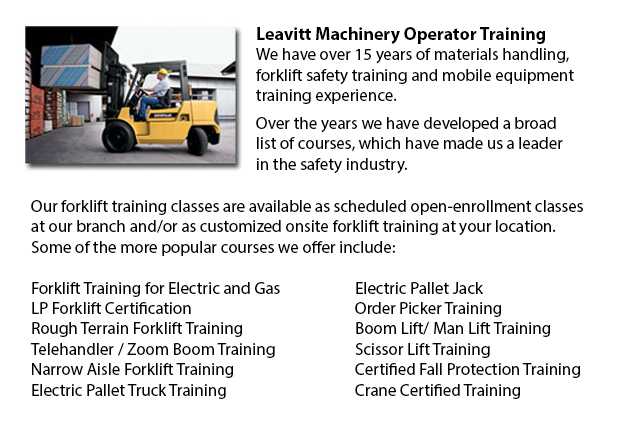
Rough Terrain Forklifts Training Sudbury - There are in fact two unique classifications of forklifts within the materials handling market, the industrial model and the rough terrain model. Rough terrain forklifts initially came on the market in the 1940's and were being predominantly utilized on rough roads, best for places where no covered surfaces were existing, like construction sites and lumberyards.
Typically, most rough terrain lift trucks are run on a propane, diesel or gas driven internal combustion engines with a battery used for power. Some manufacturers are playing with rough land forklifts that consume vegetable matter and run from ethanol. Large pneumatic tires with deep treads typify these forklifts to permit them to grab onto the roughest ground type devoid of any slippage or sliding.
The initial styles of all terrain forklifts were able to transport weights of up to 1000 lbs, via blades that could slide underneath the item, lift it a slight bit and then move it to a different location. After a decade on the market, all terrain vehicles had been given supplementary hauling strength to about 2000 lbs capacity. In the 1960's telescoping booms were added, permitting them to stack supplies a great deal higher than in earlier years. The telescoping model characteristic is a staple of most rough terrain forklifts nowadays. Present versions are capable of managing well over 4000 lbs thanks to the continuous improvements over time. Telescoping ability has also improved with some versions reaching a height of 35 feet. Operator safety has also become a focus with some all terrain forklifts now designed are outfitted with an enclosed cab for the driver, as opposed to the older open air seating capacity.
The rough terrain lift trucks on the market these days both function admirably on unpaved surfaces and paved floors. This kind of all terrain forklift is marketed for its' adaptability allowing the opportunity for organizations to use one unit to carry materials from an outside working area into a warehouse.
-
Terex Forklift
Terex Forklift Forklift Training - Terex Forklifts takes immense pleasure in producing quality equipment that helps improve their customers' efficiency while standing by their mission to offer a cost effective yet reliable product line. Through sever... More -
Pallet Lifts
Pallet Lifts Training Sudbury - A pallet lift is a device built in particular for moving pallets of varying weights and sizes. They may be utilized in conjunction with cranes, platform lifts and other heavy duty machinery as an attachment piece or to... More -
Scissor Lifts
Scissor Lift Training Sudbury - The scissor lift or platform lift, is a mechanical industrial lift that may be tailored to be utilized in retail, wholesale, manufacturing and production settings. Mechanized scissor lifts have been used chiefly within... More -
Komatsu Forklift
Komatsu Forklift Training Sudbury - Komatsu Forklift U.S.A. Inc. has a very good reputation for building reliable and robust lift trucks. Komatsu is recognized around the globe as a company with a prosperous heritage while maintaining an excellent st... More -
Pneumatic Forklifts
Pneumatic Forklifts Training Sudbury - Widely utilized in shipping plants, the pneumatic forklift or pallet vehicle, may be utilized to transfer resources that are positioned on top of pallets. A pneumatic forklift typically has a set of metal blades... More

Forklift Certification Sudbury
TOLL FREE: 1-888-254-6157
Sudbury, Ontario
forkliftcertificationsudbury.com
Email Us
About Us


